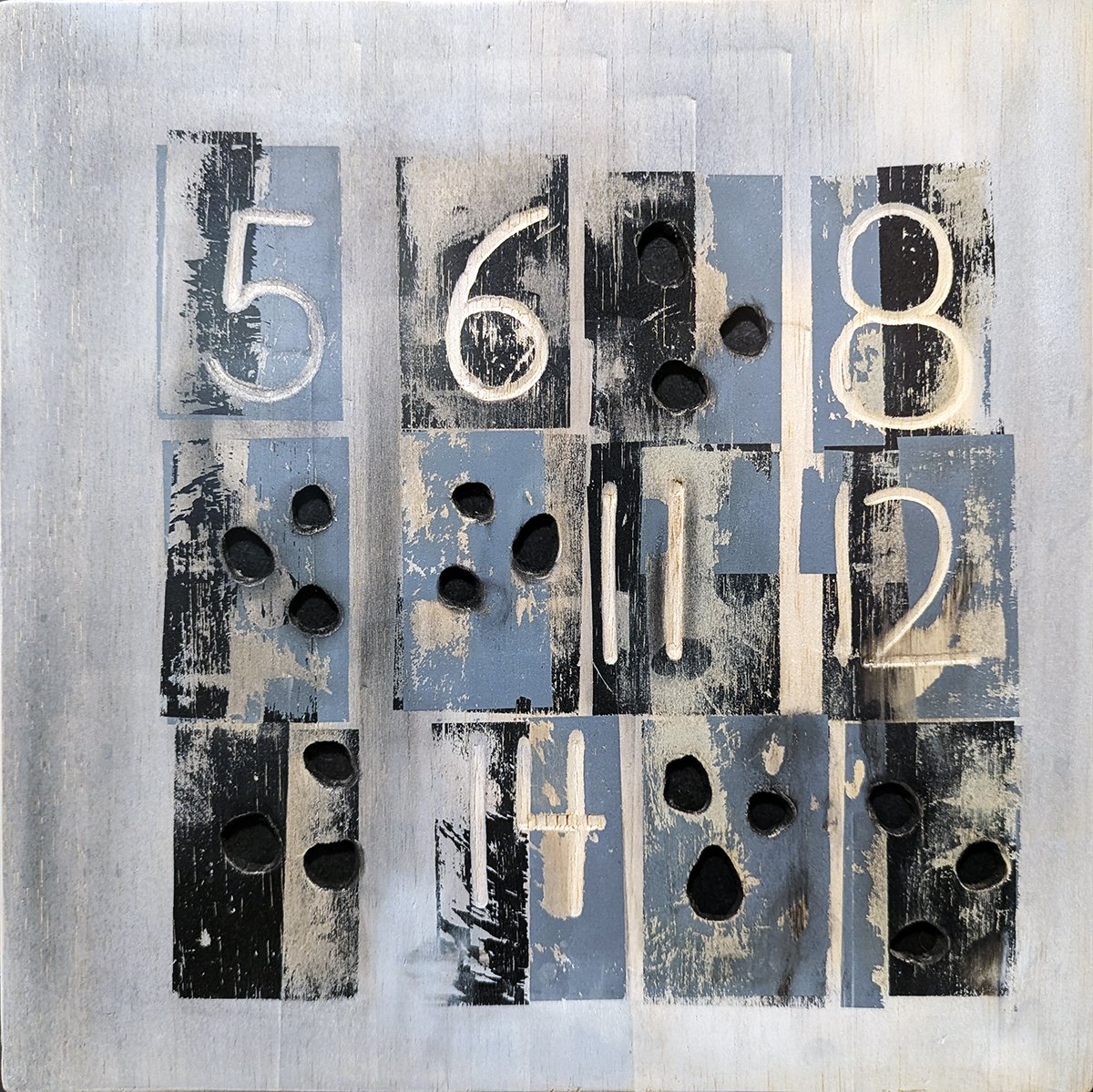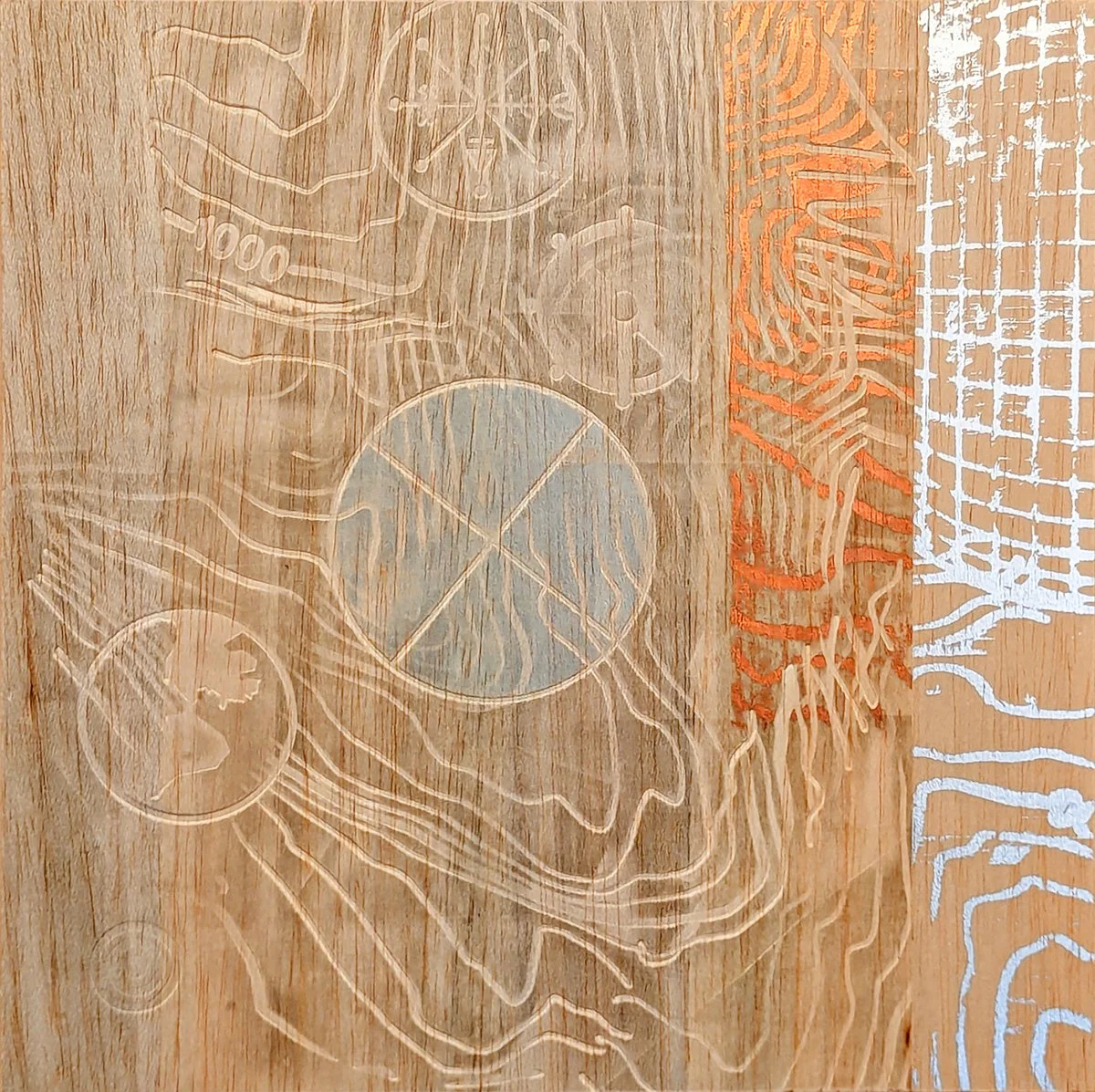Gail Watson
Gail Watson
Sangre de Cristo Arts and Conference Center
Helen Thatcher White Regional Gallery
210 N. Santa Fe Avenue, Pueblo, CO 81003
August 22–November 15, 2025
Admission: Adults: $12.00, Children, Military, and Seniors 65+: $10, Members: free
Review by Raymundo Muñoz
If you haven’t been to the Sangre de Cristo Arts and Conference Center in Pueblo, Colorado, its beautiful architecture and strong variety of arts programming year round make it worth a visit. The exhibition currently on display in the Center’s Helen Thatcher White Regional Gallery is by letterpress printer and book artist Gail Watson. Comprised of recent and past foil stamped, two-dimensional works from three separate series, Sense of Place | Topophilia, Boom, and Electrons and Labyrinths, it deals with space and place in general and specific ways. While the subject matter series-to-series is wide-ranging—from the terrestrial to matter’s most elemental forms—Watson elegantly ties the disparate elements together with her consistent aesthetic and process, striking the sweet spot between rough and refined.
An installation view of the Gail Watson exhibition in the Helen Thatcher White Regional Gallery at the Sangre de Cristo Arts and Conference Center. Image by Raymundo Muñoz.
Central to all of her work is Watson’s well-honed, multilayered process of foil stamping and drawing in pastel on wood. Foil stamping is a printing process wherein metallic or opaque color foil is stamped through heat and pressure onto a surface. While usually applied to soft materials like leather, the artist has been employing the process on soft woods like basswood and balsa since 2009.
Gail Watson, Copper Topo, pastel and foil on wood, 12 x 12 inches. Image by Raymundo Muñoz.
Depending on the viewing angle, you might notice a subtle gloss or a bright shimmer (the warm luster of Copper Topo, for instance). Additionally, Watson uses polymer plates to hammer designs into the surface, followed by drawing directly on the wood and applying the creamy accents of pastels. The overall effect is graphic work that’s textured and appears softly aged (as in Moving Spheres).
Gail Watson, Boom 8, pastel and foil on wood, 12 × 36 inches. Image by Raymundo Muñoz.
The process lends itself well to her conceptual interests too. Take the Boom series, marked by rough-hewn holes, a bric-a-brac of multicolored numbers, and a roughly painted look that draws inspiration from boulders drilled at Leadville Boom Days. This celebration of mining history includes competitions like single and double jack and jack leg drilling. It’s a wince–inducing sport, especially double jack—a harrowing test of trust, requiring one person to hold and turn a steel chisel in concert with another that hammers away to drill into solid stone. (Literally, people lose fingers in the competition!) Based as much on precision and accuracy as strength and stamina, it’s a violent and bloody display and a curious inspiration for the artist’s work.
Gail Watson, Boom, pastel and foil on wood, 12 x 12 inches. Image by Raymundo Muñoz.
The impact, pressure, and decisive mark-making of mining, though, seems at home in Watson’s art practice. The connection to stone and hand tools also conjures up images of ancient cave paintings and carvings—mysterious and graphic, yet hinting at deep understandings and cultural narratives. Plus, consider how the seemingly random orientation of numbers and holes, in Boom, for example, adds a rollicking and rambling liveliness to the artist’s fine finishes, while also hinting at Colorado’s long and interesting extractive history.
Gail Watson, Moving Spheres, pastel and foil on wood, 12 x 12 inches. Image by Raymundo Muñoz.
Now residing in her home state of New York, the longtime Colorado resident considers her own connection to the land in her most recent series Sense of Place | Topophilia. It is a tight and well-composed body of work that she calls, “an exploration of my sense of place on our planet.” Watson’s compositions are based on spheres and globes and make deft use of the U.S. Geological Survey’s topographical maps, geo coordinates, and lines of latitude and longitude.
Gail Watson, Round Sectional Sphere, pastel and foil on wood, 16 inches in diameter. Image by Raymundo Muñoz.
In Round Sectional Sphere, against a greater baby blue globe two smaller globes reside in their own rectangular sections, interlaced with the undulating waves of topographical maps. Similarly, in Sectional Topo 1, opposing globes set in their own geometries connect in ways through their respective grids and the graphical representations of sloping terrain.
Gail Watson, Sectional Topo 1, pastel and foil on wood, 12 x 12 inches. Image by Raymundo Muñoz.
Knowing the terrestrial history of the artist, the opposing globes and interacting land lines make sense as representations of a life split between two very different mountain ranges and worlds (i.e. Rocky Mountains and Catskills), yet still on the same planet.
A view of five works by Gail Watson from the Electrons and Labyrinths series at the Sangre de Cristo Arts and Conference Center. Image by Raymundo Muñoz.
In the oldest series titled Electrons and Labyrinths, Watson drills in further, to the center of it all: the atom and the mysteries of life. This group of works is the loosest in design, but marks appropriately the beginning of her dedication to a process that suits her so well. Initially prompted by the poem “Trying to Place the Spirit After Death” penned by Letterpress Depot Executive Director, artist, and poet Tom Parson in 2009, Watson created “a new atom with arbitrary electrons” that appears repeatedly in the series, along with labyrinth designs.
Gail Watson, Waiting Labyrinth, pastel and foil on wood, 12 × 12 inches. Image by Raymundo Muñoz.
The labyrinthine forms visually echo the atomic orbital motif, which acts as a kind of bullseye, beckoning the viewer to search for the maze’s heart. In the context of the poem’s title at least, where does the spirit lie, but at the atom’s nucleus? (And maybe life and afterlife is in the electron cloud, seeking higher and higher energy levels?).
Gail Watson, Summer Labyrinth, pastel and foil on wood, 24 x 24 inches. Image by Raymundo Muñoz.
Philosophy aside, Summer Labyrinth is a handsome piece, full of bluster and luster, echoing its message like ripples set about by stones tossed into a warm lake.
An installation view of Gail Watson’s Sense of Place | Topophilia series at the Sangre de Cristo Arts and Conference Center. Image by Raymundo Muñoz.
Visually, this series seems at peace with Topophilia, with its geometric designs and overarching sense of connectedness, but conceptually it feels like an origin story to Watson’s Boom series. We might ask: what connection does mining have to the splitting of the atom to unleash and harness the energetic and/or destructive resources within?
Gail Watson, Geographer's Mark, pastel and foil on wood, 12 x 12 inches. Image by Raymundo Muñoz.
As much as this exhibition is focused on representations and meditations on space, the subject of time is always implied. From the beautifully aged aesthetic of Watson’s art and references to Colorado history (and the artist’s own history, no less) to the movement of subatomic particles, it takes time to get somewhere worthwhile. With the labyrinthine paths you take to find what you’re looking for…well, all you can hope for is more boom than bust at the center.
Raymundo Muñoz (he/him) is a Denver-based printmaker and photographer. He is the director/co-curator of Alto Gallery and board president of 501(c)(3) non-profit Birdseed Collective. Ray is guided by the principle that art is a bridge, and it connects us to ourselves and each other across time and space.



















